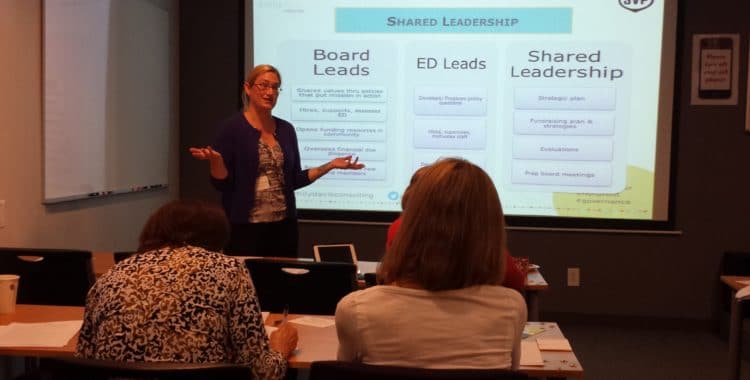


Tuesday, June 17th, 2014
By Julie Simmons SVP Spring 2014 Community Outreach Intern, with Emily Davis of Emily Davis Consulting
On June 12 SVP Boulder County hosted a BOARDS WITH BRAINS session on nonprofit board governance with BoardSource Certified Governance Trainer Emily Davis, President of Emily Davis Consulting. BOARDS WITH BRAINS is SVP’s board governance professional development series, focused on leadership best practices for Boulder County’s nonprofit staff and volunteers.
Session attendees included board chairs, board members, and nonprofit staff looking for information about a broad range of governance issues, including fundraising, financial management, managing personalities, and recruitment.
To begin, attendees were given a handout describing BoardSource’s “10 Basic Board Responsibilities,” and asked to consider how their boards perform as a whole on each measure, as well as how they do as individual board members. This was an excellent exercise to get the board to focus on the areas that truly need improvement.
Fundraising and Financial Management
When it comes to fundraising, nonprofit boards should begin close to home; 100% board member giving is an absolute must – it demonstrates essential accountability and confidence in the organization for other donors and funders. Foundations see this as an indication of whether the board truly has confidence in the organization. Board members should be held to their minimum donation requirement through the “give, get, or get off” convention. This rule says that board members should either be able to give the minimum donation themselves, should be able to raise it through bringing in new donors or matching donations, or that board member should step down from the board.
One example discussed in the session was having board members raise their minimum commitment from other donors. This can actually be a favorable option for many organizations because it brings new donors into the mix and expands their reputation. Emily encouraged board members to not only give a financial contribution, but to also leverage gifts from new donors; this provides an opportunity for the organization to develop relationships with new donors and develop greater investment.
 Emily took time to highlight how much time is involved in various elements of fundraising – prospecting, cultivating and stewarding, asking, and acknowledging. Her graphic showed that asking, the most dreaded aspect of fundraising, is actually only a small part of the fundraising cycle. In fact, much more focus is needed on cultivating donors as well as thanking existing ones.
Emily took time to highlight how much time is involved in various elements of fundraising – prospecting, cultivating and stewarding, asking, and acknowledging. Her graphic showed that asking, the most dreaded aspect of fundraising, is actually only a small part of the fundraising cycle. In fact, much more focus is needed on cultivating donors as well as thanking existing ones.
Managing Personalities
Often, there are predictable volunteer “types” who enjoy serving on nonprofit boards. Understanding the motivations and needs of these different profiles can help you manage personalities on the board so that everyone is able to give his or her best. For example, a “Busy Person” needs to be given tasks to stay engaged with their board; if not well engaged, s/he’ll lose interest and move on to something that uses his/her talents more effectively. “Organizers” and “Creative Volunteers” are often well-matched together; the “Creative” volunteer comes up with new ideas while the “Organizer” helps get those things done. In pairing them, each gets a chance to use their strengths to the organization’s benefit.
While individual board members are an essential piece, in board governance the needs of the organization must come first. So when conflicts arise, it’s important to keep the focus on the mission and what will best serve that mission. You want to bring the best people on the board to help the organization and be able to retain them through great orientation and effective meetings. As the organization grows, new board members with fresh perspectives might be needed.
The sign of a great leader is one that has helped an organization grow past his/her skills and is ready for the next chapter. Diversity of opinions is good for keeping the organization moving forward and challenging the status quo so that the best options are available to the organization. At times, an outside facilitator can help direct conflict in a constructive direction or provide education to keep focus on the essentials of board governance. Conflict is constructive when it leads to creative solutions.
Recruitment
Regarding board recruitment, Emily shared her personal rule: she serves on more than two boards at a time. This helps board members avoid the problem of being unable to give enough (time and/or money) to any one organization. Also, the ideal board size is typically between nine and eleven people. Too few people leaves the board without adequate resources, while too many decreases peer accountability and can be difficult to manage.
While numbers like these and the “give, get, or get off” rule might restrict board recruitment, technologies can help expand recruitment pools. For example, virtual meetings let board members who live far away or travel still participate in a way that doesn’t lessen a board’s effectiveness. Emily cautioned that having consistent attendance and virtual meeting policy are important for meeting remotely.
For more on board recruitment, join SVP Boulder County for the next month’s BOARDS WITH BRAINS session. Register now and learn more about this July 10 “Building the Bench” session, to learn in greater depth and detail how to recruit the right smart, impactful board members you need for your organization.